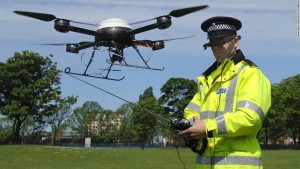 As more law-enforcement agencies welcome UAV deployment as an effective force multiplier, police associations – groups that represent and empower police officers – are taking notice.
As more law-enforcement agencies welcome UAV deployment as an effective force multiplier, police associations – groups that represent and empower police officers – are taking notice.
DRONELIFE recently contacted several domestic and international police organizations to gauge the “drone buzz” among police agencies. Although some chose not to comment or had not yet established a view on the issue, others are tackling the future of drone use head on.
The National Sheriffs’ Association is seeing a sharp interest in drones pop up among its thousands of members. The group, based in Alexandria, Va., is “dedicated to serving the Office of Sheriff and its affiliates through police education, police training, and general law enforcement information resources.”
Given its mission, it’s not surprising to see the NSA’s membership look to its leaders for advice on drone deployment and training.
“Two years ago, we received several questions [about drone] training and liability,” Deputy Executive Director John Thompson said in an exclusive DRONELIFE interview.
Since county-level sheriff’s offices usually cover more square miles than their municipal counterparts, it makes sense the agencies may find drones more useful.
And, since sheriff agencies would arguably use drones more for search and rescue in remote regions and less for crime-surveillance, privacy issues are not as evident. In fact, Thompson says the NSA has not received any drone-related privacy questions.
Although the NSA offers several training seminars for sheriffs, Thompson said the group is still considering its options for in-depth classes about drones.
“We have inquired of several universities about a training program on the proper use, privacy requirements and liability,” Thompson said. “As of this date, we have not done anything.” The NSA did, however, offer the Airborne Law Enforcement Association’s “UAS Operations Course” during a 2015 expo.
According to an NSA magazine article last year, drones may be able to fill a dire need for cash-strapped sheriffs who can’t afford manned aircraft. “Less than 225 of [sheriff] agencies have manned air support units,” wrote police-drone expert Alan Frazier.
And Frazier would know — he leads the UAS unit for the Grand Forks County Sheriff’s Office in North Dakota and is considered a pioneer in UAS aviation.
In order to address the funding gap for small departments, Frazier’s department received FAA approval in June to deploy the Northeast Region Unmanned Aircraft System unit on an as-needed basis to any domestic law enforcement agency. Frazier emphasizes training as the most important factor to address and Thompson agrees.
“It is likely [drones] will be useful tool for law-enforcement but agencies must be trained on the proper use, privacy laws and the liability,” Thompson said. “NSA will have to take the lead in providing this training and educating to our members.”
Although the International Association of Chiefs of Police didn’t provide a comment for this article, the group’s Aviation Committee has released guidelines to its members concerning drone use. The group, which includes 20,000 law enforcement professionals from 100 countries, strongly advises member agencies to focus on privacy concerns within their jurisdictions.
“The agency should engage their community early in the planning process, including their governing body and civil liberties advocates,” the report states, adding that police must “assure the community that it values the protections provided citizens by the U.S. Constitution [and] that the agency will operate the aircraft in full compliance with the mandates of the Constitution, federal, state and local law governing search and seizure.”
The IACP warns police that weaponizing police drones “is strongly discouraged.” In fact, the IACP doubts the current state of drone tech would provide “the ability to effectively deploy weapons from a small UAV.”
The recent mass shooting in Dallas underlines public fears of police-deployed, weaponized drones. Following the death of the Dallas shooter, many subsequent media reports have inaccurately labeled the now infamous bomb-carrying robot a drone.
“Public acceptance of airborne use of force is likewise doubtful and could result in unnecessary community resistance to the program,” the report states.
Ultimately, the IACP believes any drone adoption program by police nationwide must be community-based. “Despite their proven effectiveness, concerns about privacy threaten to overshadow the benefits this technology promises to bring to public safety.”
Jason is a longstanding contributor to DroneLife with an avid interest in all things tech. He focuses on anti-drone technologies and the public safety sector; police, fire, and search and rescue.
Beginning his career as a journalist in 1996, Jason has since written and edited thousands of engaging news articles, blog posts, press releases and online content.
Email Jason
TWITTER:@JasonPReagan
Subscribe to DroneLife here.







[…] by using the UAS, including a home invasion robbery and sexual assault in Samson. → DroneLife Exclusive: Police Groups Address Drone Issues – DRONELIFE recently contacted several domestic and international police organizations to […]